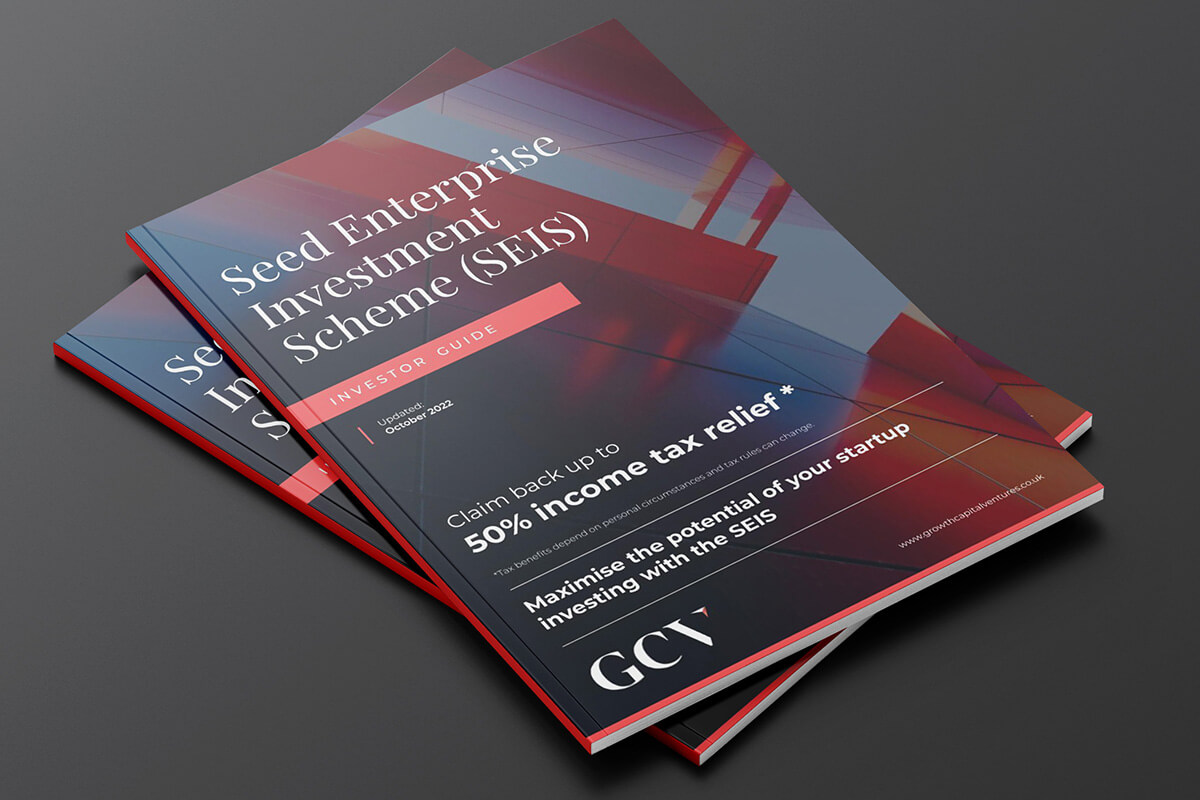
SEIS Tax Reliefs
When investing into UK startups, the Seed Enterprise Investment Scheme (SEIS) offers a range of especially generous tax reliefs for investors keen to minimise the risk and maximise the returns of their venture capital investments.
Firstname Lastname & Firstname Lastname
Position & Position, Company
Which tax reliefs does the SEIS provide?
5 Powerful Tax Incentives
Renowned for its host of tax reliefs, the Seed Enterprise Investment Scheme has been popularised for its ability to drive startup growth and innovation with the help of attractive tax incentives ranging from 50% income tax relief to capital gains reinvestment relief.
Offering some of the most generous tax incentives available in the UK alternative investment space, the SEIS's five main tax reliefs primarily serve to minimise the risk and maximise the returns associated with investing in startups, whilst facilitating additional portfolio diversification and tax planning benefits.
1. Income Tax Relief
50% Income Tax Relief up to £60,000
Undoubtedly one of the most attractive SEIS tax reliefs, investors can claim 50% income tax relief on investments of up to £200,000 per tax year, provided the shares are held for at least three years. This headline level of tax relief surpasses the 30% offered by its sibling scheme, the Enterprise Investment Scheme.
Included to help offset a proportion of the risk commonly attached with investing in startups, this incentive alone can allow investors to claim up to £50,000 back in tax per annum (providing income tax eligibility is met).
Alongside having the option to claim income tax relief for the year that the investment was made, SEIS carry back relief can allow an investor to treat the investment as though it was made the year prior and thus claim 50% income tax relief for that year instead.
For example: if an investor pledges £40,000 into an SEIS investment opportunity - once the SEIS3 form is received following the issuing of shares - they will then have the option to claim up to £20,000 back from their current or the previous tax year's income tax bill.
In order to claim SEIS income tax relief, investors have the option to either submit their completed SEIS3 form to HMRC and have the tax relief deducted from their PAYE income (where applicable) or include the details of their investment(s) when completing an annual tax return (to which the SEIS3 form will be provided as supporting documentation).
2. Tax Free Growth
Gains 100% Exempt from CGT
Another tax advantage mirrored by both the EIS and SEIS, capital gains tax relief means that any gain realised in the value of SEIS shares come the point of disposal is 100% free of CGT.
Not being liable to the usual 20% CGT charge (or 28% in the case of property sales) due in the UK when disposing of assets as an higher/additional rate taxpayer, SEIS investments have the power to considerably reduce an investor's tax bill, and in doing so further maximise the significant returns startup investments have the potential to generate.
For example: if an investor pledges £40,000 in an SEIS investment opportunity, and their shares grow in value to £120,000 at the point of disposal, the £80,000 gain (that in the case of most assets would be liable to a £16,000 deduction) will be 100% free of capital gains tax.
To qualify for CGT exemption, SEIS shares must have been held for a minimum of three years either from the date they were issued or the official commencement of trading (whichever is later) and throughout that three year term the portfolio company must continue to remain within the bounds of SEIS eligibility.
Being classified as an exempt gain and therefore an automatic relief, any gain from an SEIS investment is not required to be included in your usual disposal proceeds, but should you follow the route of filing an annual tax return, details of the investment should be included in the capital gains summary form.
3. CGT Reinvestment Relief
Halving the CGT due from any Chargeable Asset
One of the scheme's lesser understood, but perhaps most rewarding tax reliefs, SEIS reinvestment relief allows investors to reduce the CGT they're due on any chargeable asset (elsewhere than the SEIS) by up to 50%, should this gain be reinvested into SEIS qualifying shares.
Providing investors with the opportunity to halve the capital gains tax they pay when disposing of chargeable assets ranging from stocks, to property, to personal possessions worth more than £6,000, SEIS reinvestment relief has the ability to significantly reduce investor tax bills.
For example: should a higher rate taxpayer sell a property (other than their first home) and make a £100,000 gain, where usually they would be liable to pay £28,000 in capital gains tax, SEIS reinvestment relief would halve this payment to £14,000 should the full sum of the gain be reinvested into an SEIS investment opportunity.
To receive the full 50% reinvestment relief, the entire sum of the gain must be reinvested, should any less be reinvested, relief will be limited to half of the amount invested. Importantly, in order to claim SEIS reinvestment relief, investors must have already claimed income tax relief on their SEIS investment for that year.
4. Inheritance Tax Relief
Negating the 40% IHT due on UK Estates
All SEIS investments are entirely inheritance tax-free, meaning investors can pass down the full value of their shares without the threat of being charged 40% IHT should their estate be valued over £325,000 (the UK's current maximum IHT-free threshold).
A tax relief available due to the SEIS' eligibility for UK Business Property Relief (BPR), full inheritance tax exemption is unlocked for investors once shares have been held for at least two years (five years less than the minimum holding period required for many other IHT planning tools such as gifts or trusts).
For example: if an investor already exceeding the £325,000 IHT nil-rate band pledges £200,000 in SEIS shares two years before passing, rather than having to forfeit £80,000 of that sum in inheritance tax, they can pass the full value of their shares on IHT and CGT free.
IHT relief is obtained by claiming business relief (BR). A claim for BR is normally made during the settlement of the shareholder’s estate, whereby the executors will need to complete a copy of probate return form IHT 412 and return this to HMRC as part of the overall probate process. HMRC will then assess the claim.
5. Loss Relief
Minimising Startup Investment Risk
Acting as an insurance policy to further minimise the risks investing in startups can pose, SEIS loss relief is another tax relief shared by both the SEIS and the EIS, that allows investors to offset any potential losses against their marginal rate of income tax or capital gains tax.
To calculate SEIS loss relief, first you must find your effective loss (the original investment minus the return realised and any income tax relief that has already been claimed). From there you can either multiply that figure by your marginal rate of IHT or CGT to find how much of the SEIS relief you are due.
To work this out for your own potential investments, you can use an SEIS calculator.
For example: if a higher rate taxpayer invests £40,000 in an SEIS opportunity, realises £10,000 in returns, and has already claimed £20,000 in income tax relief, their effective loss of £10,000 could then be multiplied by their 45% rate of income tax to claim back a further £4,500 in loss relief, making their total net loss just £5,500.
Whilst additional personal tax circumstances can be considered when claiming SEIS loss relief, in essence the process is relatively straightforward and can be carried out by completing the SA108 form on an online or paper self-assessment form once SEIS3 forms have been received.
Free Investor Guide
Seed Enterprise Investment Scheme
-
- Access 50% income tax relief
- Claim 50% capital gains reinvestment relief
- Pay zero capital gains tax when selling SEIS shares
- Pass on your investment free of inheritance tax
- Claim loss relief should an unexpected event arise

Our Most Recent SEIS-eligible Opportunities
Our Most Recent SEIS-eligible Opportunities
Having hosted a number of SEIS-eligible investment rounds for a range of portfolio companies residing in a variety of industries, at GCV we possess a wealth of experience in originating and facilitating growth-focused, impact-driven SEIS investment opportunities.

Business Finance Market (trading as Finance Nation)
| Sector: | Fintech & Banking |
|---|---|
| Target Sought: | £ 150,000 |
| Funds Raised: | £ 225,000 |
| Round: | Round 1 |
| Investment Type: | Equity |
| Tax Schemes: | EIS, SEIS |

Growth Capital Ventures
| Sector: | Fintech |
|---|---|
| Target Sought: | £ 500,000 |
| Funds Raised: | £ 561,000 |
| Round: | Round 1 |
| Investment Type: | Equity |
| Tax Schemes: | EIS, SEIS |

Growth Capital Ventures
| Sector: | Fintech |
|---|---|
| Target Sought: | £ 1,000,000 |
| Funds Raised: | £ 1,290,410 |
| Round: | Round 2 |
| Investment Type: | Equity |
| Tax Schemes: | EIS, SEIS |

Hive.Hr
| Sector: | HR Tech |
|---|---|
| Target Sought: | £ 150,000 |
| Funds Raised: | £ 303,000 |
| Round: | Round 1 |
| Investment Type: | Equity |
| Tax Schemes: | EIS, SEIS |

Intelligence Fusion
| Sector: | SaaS |
|---|---|
| Target Sought: | £ 400,000 |
| Funds Raised: | £ 556,800 |
| Round: | Round 1 |
| Investment Type: | Equity |
| Tax Schemes: | EIS, SEIS |

n-gage.io
| Sector: | SaaS |
|---|---|
| Target Sought: | £ 150,000 |
| Funds Raised: | £ 170,000 |
| Round: | Round 1 |
| Investment Type: | Equity |
| Tax Schemes: | EIS, SEIS |

Business Finance Market (trading as Finance Nation)
| Sector: | Fintech & Banking |
|---|---|
| Target Sought: | £ 150,000 |
| Funds Raised: | £ 225,000 |
| Round: | Round 1 |
| Investment Type: | Equity |
| Tax Schemes: | EIS, SEIS |

Growth Capital Ventures
| Sector: | Fintech |
|---|---|
| Target Sought: | £ 500,000 |
| Funds Raised: | £ 561,000 |
| Round: | Round 1 |
| Investment Type: | Equity |
| Tax Schemes: | EIS, SEIS |

Growth Capital Ventures
| Sector: | Fintech |
|---|---|
| Target Sought: | £ 1,000,000 |
| Funds Raised: | £ 1,290,410 |
| Round: | Round 2 |
| Investment Type: | Equity |
| Tax Schemes: | EIS, SEIS |

Hive.Hr
| Sector: | HR Tech |
|---|---|
| Target Sought: | £ 150,000 |
| Funds Raised: | £ 303,000 |
| Round: | Round 1 |
| Investment Type: | Equity |
| Tax Schemes: | EIS, SEIS |

Intelligence Fusion
| Sector: | SaaS |
|---|---|
| Target Sought: | £ 400,000 |
| Funds Raised: | £ 556,800 |
| Round: | Round 1 |
| Investment Type: | Equity |
| Tax Schemes: | EIS, SEIS |

n-gage.io
| Sector: | SaaS |
|---|---|
| Target Sought: | £ 150,000 |
| Funds Raised: | £ 170,000 |
| Round: | Round 1 |
| Investment Type: | Equity |
| Tax Schemes: | EIS, SEIS |
SEIS Tax Reliefs FAQ
How do I apply for each of the SEIS tax reliefs?
To apply for tax reliefs on SEIS investments, you’ll need to complete the SEIS3 form, which is issued by the company once you've invested and received your shares. You can submit this form to HMRC either directly or as part of your self-assessment tax return.
The SEIS3 form will serve as supporting documentation for your claim. Depending on the relief, you may also need to provide additional information, such as details of your investment for capital gains tax (CGT) exemptions or losses.
For income tax relief, you can either claim it in the year the investment is made or use carryback relief to apply it to the previous tax year.
What types of investments qualify for SEIS?
SEIS applies to investments in small, early-stage companies that meet specific criteria. The company must be a UK-based business with fewer than 25 employees and gross assets of less than £200,000. It must also be carrying out a qualifying trade or activity and must not have raised more than £150,000 through SEIS investments.
These businesses must also not have been trading for more than two years and must be looking to grow and expand with the help of funding from SEIS investors. Each investment must meet these criteria to be eligible for the associated tax reliefs.
What happens if I sell my SEIS shares before the minimum holding period?
If you sell your SEIS shares before the minimum holding period of three years, you will lose eligibility for some of the tax reliefs, including the capital gains tax (CGT) exemption. Selling shares early means that you will not benefit from the full tax-free growth on any gains from the investment. But it is worth noting that unlike other investments, shares can only be sold after the company undergoes some form of exit, which comes usually well after the minimum holding period.
However, you may still be eligible for other reliefs, such as income tax relief, depending on your specific circumstances. To fully benefit from the tax incentives, it’s important to hold onto your SEIS shares for the required period.
What happens if a company I invest in fails?
If the company you’ve invested in under SEIS fails, you can claim seis loss relief, which allows you to offset any loss against your income tax or capital gains tax. The loss relief is calculated based on the amount you originally invested minus any income tax relief you’ve already claimed. If the company goes into liquidation, you can reduce your taxable income by the amount of your effective loss, which can significantly mitigate the financial risk. This relief provides a safety net, helping to ease the potential impact of a startup failure.
Is there a limit to how much I can invest under SEIS for these tax reliefs?
Yes, there is a limit to how much you can invest in SEIS for tax relief. previously £100,000 you can now invest up to £200,000 per tax year and still claim the associated reliefs. This amount is the maximum eligible for relief in any given year, and if you invest more than this, you won’t receive SEIS relief on the additional investment. If you plan to invest more and want to benefit from tax reliefs, you can look at other schemes, such as the Enterprise Investment Scheme (EIS), which has a higher investment threshold.
Latest Updates
From tax efficient investing to joint venture property investing, our blog is full of news, information and insights.
SEIS reinvestment relief: what is it and how does it work?

How to claim SEIS tax reliefs: everything you need to know

Subscribe
Let's keep in touch
To keep up to date on news, events and investment opportunities, sign up to our newsletter here.
* You can unsubscribe at any point using the link provided in the footer of all emails, for more information about how we handle data you can view our privacy policy.
%20(3)%20(2).jpg)
